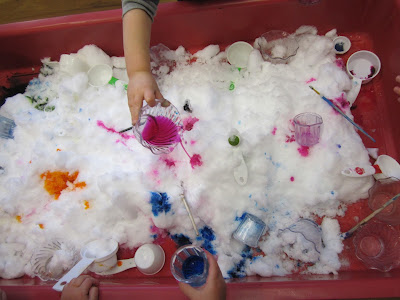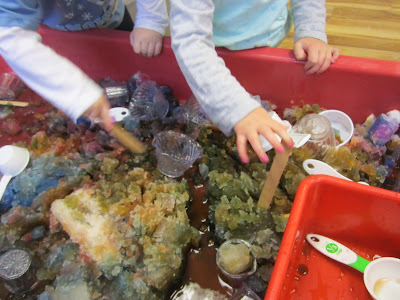The
kids love it!
They
have so much fun with this!
In conversations with teachers and reading online
blogs and comments, these phrases come up over and over again, as the reason
for planning a classroom activity, or the evaluation of how it went? “Oh, you
tried that art activity on Pinterest, how did it go?” “The kids loved it – it was
so much fun!”
Of course it was fun, they’re kids. They’re naturally
wired to have fun. If we give them an activity and they don’t have fun, that’s what we need to worry about. The bigger issue
of planning and evaluating classroom activities shouldn’t be whether they’re “fun”
or whether the kids “love it”. It should be how we observe the learning and development
taking place. We shouldn’t be planning for “fun”, we should be planning to meet
developmental objectives and to engage the children’s interests.
“I
don’t have to plan. I just put the materials out and see what they do with
them.”
Every time we enter a
classroom, choose a material, place it in a certain way on a table, floor, or
shelf, we’re planning. Teachers in play-based, discovery learning environments
sometimes shy away from this, out of fear of imposing their own ideas on the
children’s play. But the social interaction that happens between any group of
people, especially adults and children involves planning. Which materials did
you choose to put on your classroom shelves? Are they stored in baskets, boxes,
or something else? How many are there of each? When you saw that art activity
on Pinterest, or in a neighboring classroom, it sparked an idea for you that
was probably more than just “this is fun”. What did you think/hope/wonder that your
kids would do with these same materials?
Planning a play based
curriculum can sometimes feel overwhelming, as we balance what it means to “teach”
and what it means for children to explore and discover. It’s true that in a
play-based program, we aren’t teaching children to do specific tasks according
to our directions. But that doesn’t mean we aren’t teaching. Our jobs as teachers
are to observe where the children’s play is going and facilitate it, scaffold
interactions between children and the materials and between children and each
other, and to provide the opportunities for learning to take place.
Intentional teaching involves
teachers having planning and purpose in the environment, activities, and
interactions that we create, nurture, and encourage. When we choose activities,
we need to ask ourselves, “What will the children do with this? That doesn’t mean we’re requiring or expecting them
to do one specific thing, but we’re considering all the possibilities of what might happen. And how that ties back to learning and development? We need to ask ourselves what experiences am I
giving children that will spark problem solving? Collaboration? Innovation?
Creativity?
And yes, it will still be
fun, and the kids will love it. But it will be much more than that too.





















